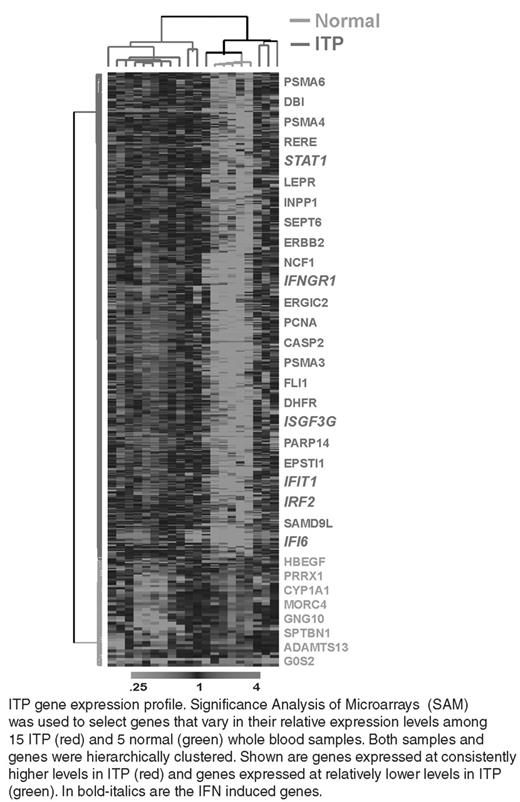Abstract
Idiopathic thrombocytopenic purpura (ITP) is an acquired disorder of unknown etiology characterized by reduction in platelet counts. To search for mechanisms underlying the pathophysiology of ITP, we used DNA microarrays to determine the ITP whole blood expression profile. We hypothesized that transcriptional changes associated with the low platelet counts will provide us with new markers for improved diagnosis in addition to novel mechanistic information to understand and treat ITP. We analyzed 29 samples from ITP patients with ages ranging from 1–70 years, of which 15 samples were from either acute or chronic ITP patients with platelet counts ranging from 2,000–56,000 X109/L and additional 14 samples were collected from patients at different stages of recovery from ITP. We used Significance Analysis of Microarrays (SAM) to select genes that best distinguished the 15 ITP samples from 5 controls. We identified 490 differentially expressed genes constituting an ITP expression profile (Figure 1). One of the most significant findings was the relatively high expression of several genes known to be induced by Interferon (IFN) in the ITP samples. Elevated expression of interferon induced genes has also been reported in patients with several autoimmune diseases (Baechler, 2006) including SLE (Baechler, 2003; Bennet, 2003 & Crow, 2003) and systemic sclerosis (Tan, 2005) suggesting that this may a common theme underlying autoimmune diseases, including ITP. In addition, we previously found changes in expression of the interferon simulated genes during a cycle of changing platelet counts in two patients with cyclic thrombocytopenia strengthening a connection between interferon signaling and platelet counts. The greatest differential expression at high significance was observed in the interferon induced genes IFIT1 and IRF2 which showed 12 and 8 fold higher expression in ITP samples relative to normal samples. Additional genes found to be expressed at higher levels in ITP included EPSTI1, PARP 14 and INPP1, while genes with reduced expression in ITP were GNG10, PMX1 and G0S2. The ITP gene signature determined by us indicates a significant role for IFN signaling events in both pediatric and adult ITP, and further identifies additional differentially expressed genes. This approach points to a number of new targets to study in the pathogenesis and prognosis of ITP.
Disclosure: No relevant conflicts of interest to declare.
Author notes
Corresponding author


This feature is available to Subscribers Only
Sign In or Create an Account Close Modal